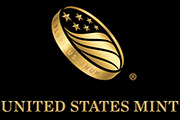Quarter-Dollar
Current Designs
Obverse: The president who proudly graces the obverse of the quarter is our first President, George Washington. The initials "JF" at the base of his neck belong to the coin's sculptor, John Flanagan. On the District of Columbia and U.S. Territories quarters and on the 50-states quarters, you'll also see the initials of William Cousins, the Sculptor-Engraver who made the modifications to the original 1938 design that allowed a larger design area on the reverse of the coin to accommodate the more intricate reverse designs.
Reverse: Beginning in 2010, the United States Mint began issuing 56 quarter-dollar coins featuring designs depicting national parks and other national sites as part of the United States Mint America the Beautiful Quarters® Program.
The five quarter-dollar coins to be released in 2012 will honor El Yunque National Forest in Puerto Rico, Chaco Culture National Historical Park in New Mexico, Acadia National Park in Maine, Hawai'i Volcanoes National Park in Hawaii and Denali National Park and Preserve in Alaska. Check out the America the Beautiful Quarters National Site Register to find out which national site in your state or U.S. territory will be honored and when.
Background
The first quarters, made in 1796, featured a depiction of Lady Liberty on the obverse and an eagle on the reverse. There was no denomination on the coin. In fact, there was no value marked on quarters until 1804, when "25c" was added to the reverse. In 1838, "QUAR. DOL." was used, and then changed to “quarter dollar” in 1892, and the denomination was consistently located on the reverse of the coin. It wasn't until the first of the new quarters was made in 1999 that "quarter dollar" was moved to the front.
The face of George Washington has appeared on the obverse of the quarter since 1932, the 200th anniversary of his birth. In 1975 and 1976, the standard eagle design on the reverse was temporarily replaced to honor the Nation’s Bicentennial of the Declaration of Independence. The reverse of the Bicentennial Quarter shows a colonial drummer and a victory torch circled by 13 stars, representing the original thirteen colonies that were referenced in the Declaration of Independence. Interestingly, it is impossible to tell a quarter minted in 1975 from one minted in 1976 – as only Bicentennial Quarters were made for those two years, and all are marked with the same 200-year date range (1776–1976).
Between 1999 and 2008, the reverse designed changed 5 times a year, through the 50 State Quarters® Program.
In 2009, the reverse design changed 6 times, through the 2009 District of Columbia and U.S. Territories Quarters Program, in honor of the District of Columbia and five U.S. territories: the Commonwealth of Puerto Rico, Guam, American Samoa, the U.S. Virgin Islands and the Commonwealth of the Northern Mariana Islands. The reverse of each quarter featured distinctly different images emblematic of the District of Columbia and each of the territories.
Instead of being made of silver, today's quarters are "clad," which means layered. The inner core is pure copper and the outer covering is copper mixed with nickel. You can even see a copper-colored line around the edge.
